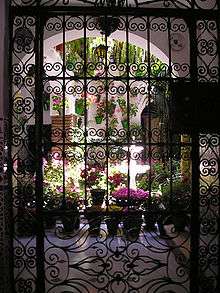Andalusian Patio



Andalusian patios are stone patios typically acting as central open spaces in a home decorated with flowers and plants. They originate from Persia, Arabia, and Spain, where it has long been customary to decorate houses and palaces with large open spaces and gardens dominated by fragrant flowers, fountains, canals, wells, ponds,[1] other decorative figures, (placed since the 15th and 16th century), frescoes with mythological scenes, and marble medallions (on walls), forming beautiful shapes each more convoluted but without breaking the harmony and with the intention to represent the Garden of the Paradise as imagined by the Muslim architects.
At first its use was intended to houses cattle, camels and horses and its construction consisted in different sticks of palm branches with a roof of straw and branches, all very weak, and later become a place of cult to the Prophet Muhammad, leaving open air, and with the conversion of religions (in Spain) was used to make prayers, readings and meditation.
There are countless examples throughout the entire region of Andalusia, but where it can find the largest number ever assembled in one place is the magnificent Alhambra of Granada, the Alcazar of Seville and many other buildings and houses in the city, or the caliphate Córdoba, which is where it developed its main features of patio in Andalusia from 10th century without producing many changes to the present day from that date.[2]
With the evolution was added bars and wood or iron windows, from which it could see the beauty of the place and in many cases without being observed (during the Muslim period.)
See also
References
- ↑ Cameron, Steffani. "Outdoor Living: The Joys of the Andalusian Patio". BuildDirect. Retrieved 6 February 2016.
- ↑ "An Overview of Andalusian Patios". Cricket Pavers. Retrieved 6 February 2016.
